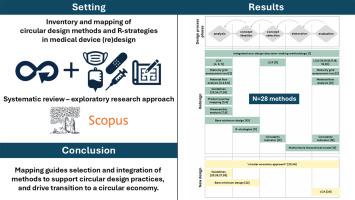在医疗器械开发中采用循环策略:沿着工程设计过程的方法映射
IF 10.9
1区 环境科学与生态学
Q1 ENGINEERING, ENVIRONMENTAL
引用次数: 0
摘要
随着人们越来越意识到医疗设备对环境的影响,人们越来越认识到在其设计中采用循环策略的必要性。这种采用包括重新设计现有设备和开发新设备,通过r策略(如Reduce、Reuse、Repair和Recycle)优先考虑效率和使用寿命。由于循环产品设计仍在兴起,因此需要在医疗设备中整合这些r策略的实用指导。本研究的重点是对循环经济原则框架下医疗器械(再)设计相关文献中明确提到的方法(设计方法)进行盘点和映射。通过对28篇论文的系统回顾,我们确定了12种方法,并将它们映射到相应的r策略和通用工程设计过程的阶段。生命周期评估(LCA)和物料流分析是两种最常用的方法,分别被引用12次和5次,并且更倾向于关注生态高效的r策略。在确定的12种方法中,有9种侧重于重新设计现有医疗设备,主要应用于分析和评价阶段。通过强调现有方法及其r策略在医疗器械(再)设计中的应用,我们的研究结果旨在为选择和整合方法提供指导,这些方法可以在整个医疗器械设计过程中支持循环设计实践,从而推动医疗保健领域向循环经济的过渡。本文章由计算机程序翻译,如有差异,请以英文原文为准。

Adopting circular strategies in medical device development: Mapping of methods along the engineering design process
With growing awareness of the environmental impact of medical devices, there is increasing recognition of the need to adopt circular strategies into their designs. This adoption involves redesigning existing devices and developing new devices, prioritizing efficiency and longevity of use through R-strategies such as Reduce, Reuse, Repair, and Recycle. As circular product design is still emerging, there is a need for practical guidance on integrating these R-strategies in medical devices. This study focuses on an inventory and mapping of methods (design methods) explicitly mentioned in the literature related to the (re)design of medical devices under the framework of circular economy principles. Through a systematic review of 28 papers, we identified 12 methods and mapped them to the corresponding R-strategies and phases of the generic engineering design process. Life cycle assessment (LCA) and material flow analysis were the two most frequently applied methods, with 12 and five citations, respectively, and tend to focus more on eco-efficient R-strategies. Nine out of the 12 identified methods focus on redesigning existing medical devices, primarily applied during the analysis and evaluation phases. By highlighting existing methods and their R-strategy applications in medical device (re)design, our findings aim to offer guidance to select and integrate methods that can support circular design practices throughout the design process of medical devices to drive the transition to a circular economy within healthcare.
求助全文
通过发布文献求助,成功后即可免费获取论文全文。
去求助
来源期刊

Resources Conservation and Recycling
环境科学-工程:环境
CiteScore
22.90
自引率
6.10%
发文量
625
审稿时长
23 days
期刊介绍:
The journal Resources, Conservation & Recycling welcomes contributions from research, which consider sustainable management and conservation of resources. The journal prioritizes understanding the transformation processes crucial for transitioning toward more sustainable production and consumption systems. It highlights technological, economic, institutional, and policy aspects related to specific resource management practices such as conservation, recycling, and resource substitution, as well as broader strategies like improving resource productivity and restructuring production and consumption patterns.
Contributions may address regional, national, or international scales and can range from individual resources or technologies to entire sectors or systems. Authors are encouraged to explore scientific and methodological issues alongside practical, environmental, and economic implications. However, manuscripts focusing solely on laboratory experiments without discussing their broader implications will not be considered for publication in the journal.
 求助内容:
求助内容: 应助结果提醒方式:
应助结果提醒方式:


